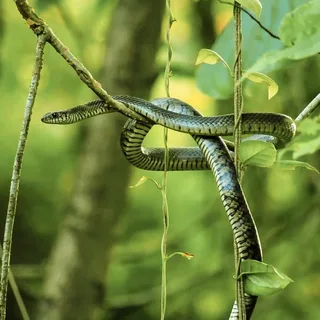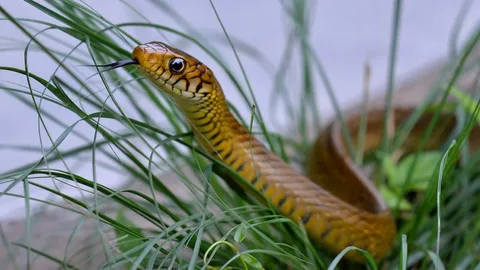Scientifically known as Ptyas mucosa, the Indian rat snake is one of the most iconic snakes in the Indian subcontinent. It can often be seen splashing through gardens, fields, drains, and even busy city streets. Despite their fearsome appearance and fast movement, rat snakes are non-venomous and extremely beneficial to humans, especially farmers. Unfortunately, due to widespread myths and lack of awareness, this helpful reptile is often misunderstood and killed out of fear.
Now let’s we will discuss the Indian Rat Snake in great depth—its biology, behaviour, ecological significance, and the critical need for its conservation.
Classification and Scientific Information
| Category | Details |
|---|---|
| Common Name | Indian Rat Snake |
| Scientific Name | Ptyas mucosa |
| Family | Colubridae |
| Genus | Ptyas |
| IUCN Status | Least Concern (LC) |
| Local Names | Dhaman (Hindi), Dharash (Marathi), Pambu (Tamil), etc. |
Rat snakes belong to the Colubridae family, which includes over 2,000 species of mostly non-venomous snakes. The Indian Rat Snake is among the longest snakes in India and is a commonly encountered species due to its adaptability to human environments.
Physical Characteristics and Identification
Length: Adult rat snakes can range from 1.5 meters (5 feet) to over 2.5 meters (8.2 feet). Exceptional individuals can exceed 10 feet.
Body: Slender and cylindrical with smooth, glossy scales. The snake is agile and highly flexible.
Coloration:
- Varies significantly with geography and habitat.
- Dry regions: Yellowish, olive, or light brown.
- Humid regions: Dark brown to almost black.
- Juveniles often have irregular patterns or bands.
Head: Narrow and elongated with round pupils—an indicator of a diurnal species.
Tail: Long and tapering, aids in balance while climbing.
Special Feature: May flatten its neck and hiss loudly when threatened, which causes confusion with the venomous cobra.
Natural Habitat and Geographic Distribution
The Indian Rat Snake is one of the most widely distributed reptiles in Asia. It has adapted to a variety of ecosystems.
Countries Found: India, Nepal, Pakistan, Sri Lanka, Bangladesh, Myanmar, Thailand, Laos, Vietnam, and parts of Southeast Asia.
Habitats:
- Deciduous and tropical forests
- Grasslands and shrublands
- Urban and suburban areas
- Agricultural fields and rice paddies
- Wetlands, ponds, and riverbanks
- Drainage systems and old buildings
The snake is an excellent swimmer and climber, enabling it to navigate both terrestrial and aquatic environments.

Diet and Feeding Habits
The Indian Rat Snake is a carnivorous predator with a preference for small vertebrates. Its primary prey includes:
- Rats and mice (hence the name)
- Frogs and toads
- Lizards
- Bird eggs and nestlings
- Occasionally smaller snakes
Hunting Strategy:
- Active during the day (diurnal)
- Uses sharp eyesight and smell to locate prey
- Captures and constricts prey using muscular coils
- Swallows prey whole, head first
Rat snakes play a pivotal role in pest control, especially in agricultural regions where rodent damage can be severe.
Behavior and Defense Mechanisms
Non-aggressive: Avoids confrontation and prefers to flee when threatened.
Speed: Extremely fast-moving snake. Can dart quickly through grass, water, or even climb trees.
Defense Tactics:
- Hisses loudly when alarmed
- Vibrates tail against dry leaves to mimic rattlesnake
- May raise the front part of its body and flatten its neck like a cobra
- Releases a foul-smelling substance from its cloaca when handled roughly
Despite these defenses, it is harmless to humans and rarely bites unless provoked.
Reproduction and Lifecycle
Breeding Season: March to July
Courtship: Males engage in wrestling matches to win mating rights.
Egg Laying:
- Female lays 6 to 15 eggs in warm, humid areas like compost pits or crevices
- Eggs are incubated naturally and hatch in 6 to 10 weeks
Hatchlings:
- Around 30 to 45 cm long
- Independent from birth
- Begin hunting small prey within days
The life span of an Indian Rat Snake in the wild may be around 10 to 15 years, though many die young due to human conflict.
Indian Rat Snake vs Other Common Snakes
| Feature | Indian Rat Snake | Spectacled Cobra | Common Krait |
| Venomous | No | Yes (neurotoxic) | Yes (neurotoxic) |
| Has Hood | No (flattens neck only) | Yes | No |
| Pupil Shape | Round | Round | Vertical (cat-like) |
| Activity | Diurnal | Diurnal/Nocturnal | Nocturnal |
Myths, Misunderstandings, and Cultural Perceptions
- Myth: Rat snakes suck milk from cows.
Fact: Snakes are lactose-intolerant. They are attracted to barns for rats, not milk. - Myth: Rat snakes chase humans.
Fact: Fast movement is often misinterpreted as chasing; they are actually trying to flee. - Myth: All large snakes are venomous.
Fact: Most large snakes in India, like the rat snake and python, are non-venomous.
Educational outreach and awareness campaigns are essential to correct these harmful beliefs.
Ecological Importance and Role in Pest Control
Benefits to Agriculture:
- Natural predator of crop-damaging rodents
- Reduces need for chemical rodenticides
Ecological Role:
- Maintains balance in food chains
- Acts as both predator and prey (e.g., to eagles, mongooses, jackals)
- Helps control populations of frogs, lizards, and small mammals
Its presence indicates a healthy ecosystem and biodiversity.
Human-Snake Conflict and Coexistence
Causes of Conflict:
- Mistaken identity (as a venomous cobra)
- Entry into human dwellings in search of rats
- Fear-driven killing
Solutions:
- Awareness campaigns in schools and rural communities
- Support for snake rescue teams
- Promote tolerance and safe removal practices
Conservation Status and Legal Protection
IUCN Red List: Least Concern (but declining in many regions due to persecution)
Legal Protection:
- Protected under Schedule II of the Wildlife Protection Act, 1972 (India)
- Illegal to capture, kill, trade, or harm the species
- Offenders may face imprisonment and fines
Conservation efforts must combine legal protection with public education and habitat conservation.
Conclusion: Living in Harmony with Nature
The Indian Rat Snake is a misunderstood ally. It silently guards our homes and farms by controlling rats and pests. While its appearance may be intimidating, its intentions are harmless—even helpful. As stewards of nature, we must learn to coexist with such creatures, understanding their role in the larger ecosystem. Protecting them is not just about saving a species, but about ensuring a healthier, more balanced environment for ourselves and future generations.
Let us educate others, respect wildlife, and protect our silent friend—the Indian Rat Snake.
Frequently Asked Questions (FAQs)
Q: Are Indian Rat Snakes dangerous to humans?
A: No. They are non-venomous and generally shy.
Q: What do I do if I see one?
A: Stay calm, keep your distance, and call local wildlife rescuers if needed.
Q: Can they climb and swim?
A: Yes. They are excellent climbers and swimmers.
Q: How do they benefit farmers?
A: They eat rodents that destroy crops and stored grain.



